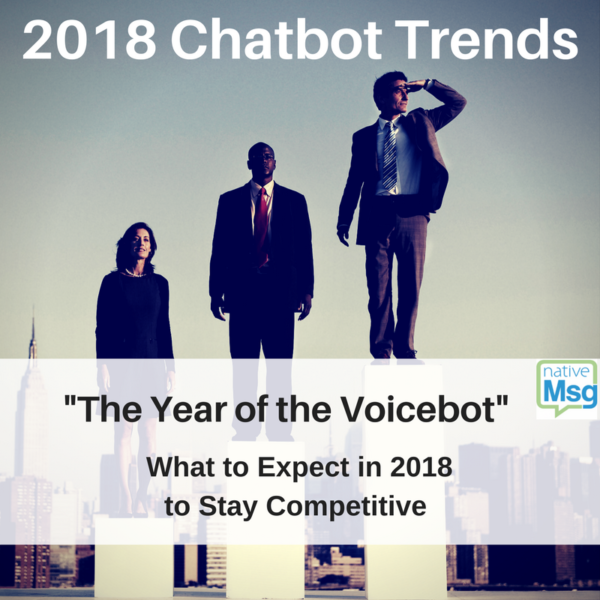
A while back, we shared chatbot 2018 trends in our post on a Simple Guide to Chatbots. As promised, here’s our larger follow-up piece to 2018 chatbot trends!
We’re heading into the home stretch of 2017, a year when we saw conversational user interfaces, i.e., chatbots, grow in usage, user experience and within all industries.
It’s no surprise that chatbots work well as the solutions for better customer service and customer experience across industries for:
- creating and tracking insurance claims.
- personal online banking.
- booking travel accommodations and flights.
- service support internally, on channels such as Slack and other management software.
- providing broader mental health access.
It’s an exciting time, as we close the books on this year and welcome in 2018, with all the possibilities for the future of conversational platforms.
But the stats overwhelmingly evidence that what’s on the horizon for 2018 is laying the groundwork for the new online experience.
The year will be a foray into how the landscape is set to dramatically change within the next 3 to 5 years.
- Chatbots are expected to increase cost-savings in billions of dollars a year in ecommerce, banking and healthcare.
- Efficient, correct chatbot interaction is expected to increase from just 20% in 2017 to 93% in 2022.
- Businesses are increasing their interactivity with other businesses within a chatbot experience to provide the ultimate experience.
The premise that chatbots will replace native apps is becoming a reality, and will continue to see that realized in 2018.
You no longer will have to hop to the site, hop to an application, it will all flow to you, according to your preferences and needs.

A Shift from Omni-Channel to Convergence
We’re not doing things the way we used to, and chatbots, AI and messaging all point toward the new digital experience coming, which is, in a word, convergence.
But what does that mean and look like? It’s a hyper-optimized focus on customer experience and customer journey. The good news for marketers and businesses is that it means over time, a multi-channel focus will evolve to an interconnectedness that your customers access from one central point.
That interconnectedness will converge within the messaging space, via chatbots and advancement in NLP and AI.
What is Convergence, Exactly?
Yes, you may have just begun to integrate an omni-channel approach to your sales funnel and marketing reach, but don’t be dismayed, this is just the next step to that process.
Content and optimization will still be integral, but instead of catering to multiple platform attributes and user-behaviors therein (and finding ways to interconnect for a great experience for your customers and brand) convergence will create a more customer-centered focus by ease of access from all points––to one point of access in the messaging space.
2018- The Year of the Voicebot: VoiceBots for Automation and Retail
In 2018, it’s estimated that 30% of interactions with tech will be conversation-based and 2018 is shoring up to be the “year of the voicebot.”
From Amazon’s Alexa to the Echo Dot, large retailers are creating voice assisted bots for making purchases, checking orders, providing product suggestions or extending brand experience with services like style or recipe suggestions. In 2017, brands have increasingly partnered with established Amazon, Google Home.
In 2018, we’ll see more brands adopting a voice-assisted bot that’s original and built for their brand: 31% of businesses plan on offering a “virtual closet” in the next few years.

WhatsApp Will Open Their API to Third-Parties
To date, third party developers do not have access to the WhatsApp platform. Make no mistake, this is a huge trough in reach and a din to organizations that want to capitalize on it.
But in 2017, WhatsApp updated their terms agreements. And, the biggest tell is that WhatsApp will allow software on the platform.
It will be wise or your organization to start planning for a strategic footprint here, now.
Evolving MMS Functionality for Businesses
As well, carriers will continue to expand their MMS functionality in offering enhanced communication services. Instead of service providers partnering with others within service structures, there will be an increase in cloud-based structures to avoid deeper structural complexities.
The underlying architecture will allow for increased conversational commerce and conversational experience created for the space.
Rich Communication Services (RCS) Will Grow
First, MMS is not going anywhere anytime soon or in 2018. Particularly as 86% of businesses use MMS in marketing.
You also need look no further than WhatsApp to connect the dots that RCS message (Rich Communication Service message) is not the only headliner: WhatsApp, is the largest messaging app in the world with over 1 billion users, where, incidentally, half of users open the app at least 10 times a day and vies as the main alternative to RCS-based service.
However, you’ll see increasing momentum in Google’s Android adoption rates across carriers.
Likewise, expect RCS messaging service to grow in parallel to SMS/MMS, again, particularly among Android users. Essentially, it’s an “SMS/MMS 2.0,” an update on rich media messaging offers in size allowance, access of other tools on our device and programs while using it.
But how does this relate to chatbot growth? It’s a connectivity path toward that future in chatbots I addressed earlier: convergence.
The service connects via your number and carrier, but the make-up, largely cloud-based, means you can create and provide conversational layers without the multi-step friction that currently happens for users–download Facebook Messenger, install an app, etc.
Users, whether on mobile or on desktop, can access this all in one space and do so while performing other functions.
If this sounds confusing, it’s because it’s a system that we haven’t quite yet experienced. But moreso, it’s the way organizations are still thinking about chatbots. Chatbots are the beginning-marker for when and how the new online experience is evolving.
Messaging as a Platform (MaaP) Will Become Mainstream
Messaging as a Platform is the space where interaction, commerce and online activity will increase and, ultimately, mostly occur.
Your chatbot is a first step in that space. Building out a conversational layer within any channel, like Facebook Messenger, is effectively the same as building an app.
But now, the app exists all within messaging, and messaging is the architecture for that app. Messaging will become Messaging as an Application (MaaA).
If you’re supremely confused, think about this like a traditional market:
- First, goods and services were available according to region, supply and demand.
- Regional trade increased variety and increased demand for new goods and services.
- Increased supply created a need for enticing customers with value and quality.
- The interconnectedness in trade resulted in a very noisy broad market and the need for segmentation of markets.
- But it’s come full-circle, virtually; the ease of shopping in a centralized location, where vendors approach you, with what you want, based on personalized metrics, ultimately underpins the concept of MaaP.
Chatbots, with advancements in AI and natural language processing, will continue to bring this experience to more users.
An increasingly intelligent virtual guide from banking to healthcare and travel will result, down the road, in a personalized service experience with deep understanding and deep learning based on your interactions across industries.

Increased Development of Conversation APIs
Businesses will continue to use REST APIs, but development in conversation APIs will increase. Conversation APIs work similarly to REST-based but can interact, machine-to-human, with natural language response.
Conversation APIs support queries in real, or natural language instead of programming language as REST APIs currently do. To be clear, too, free-form speech is mostly done using some type of REST structure behind the scenes.
Though they’re still in the beginning phase of integration, developers and businesses can apply it internally to assist in software and programming updates.
For customer-facing applications, conversational APIs will be increasingly used in banking, health insurance inquiries or remote devices, such as drones or cameras may emerge.
More Chatbots on Websites
Users are sometimes still befuddled by live chat and Chatbots. Aren’t chatbots only on messaging? Isn’t live chat usually for sites? Until now, this has been the normative user experience.
However, more and more organizations will be providing a chatbot experience embedded within their site. It will align with popular user channels and lead directly back to their site. This is an excellent lead conversion source and allows more control over an organization’s marketing and user experience strategy.
Companies are energized to integrate conversational commerce, and interfaces into their strategy.
2018 Chatbot trends point to how the digital experience will morph in the coming years. As AI continues to catch up to demand for better contextual conversations and user experiences, expect that 2018 will set the stage for the new internet experience in the next 5 to 10 years.
Want to learn more about how a conversational site or component can create huge engagement, easier lead-building and better brand experience? Get in touch with nativeMsg for a customized solution for your business.
Free Trial
Get Started With RCS
Business Messaging!
Unlock the power of RCS and revolutionize your customer engagement.



